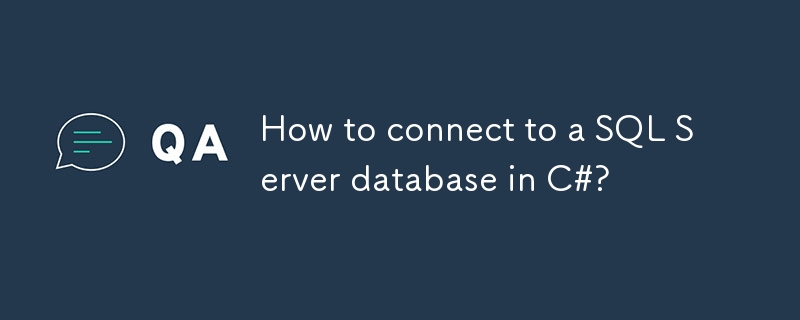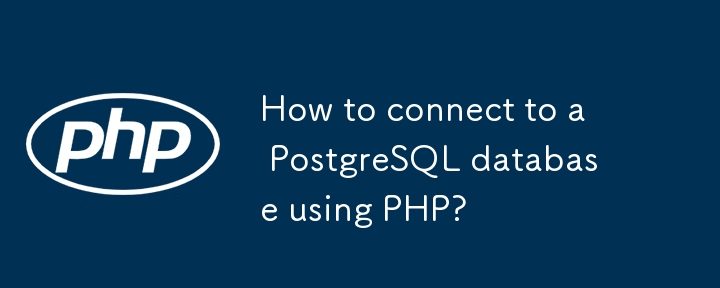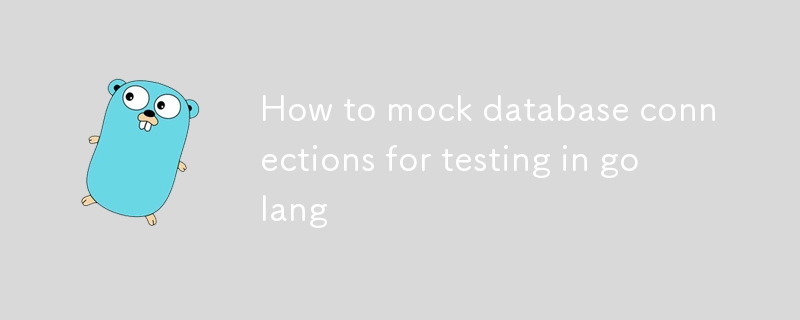Found a total of 10000 related content

How to connect to an sqlite database in golang
Article Introduction:To connect to SQLite database in Go, you need to use a third-party driver to cooperate with the database/sql interface. The specific steps are as follows: 1. Install the dependency package database/sql and mattn/go-sqlite3 drivers; 2. Import the driver in the code and use sql.Open("sqlite3", "database path") to open the connection; 3. Use db.Exec to create a table, insert data, db.QueryRow or db.Query to query data; 4. After the operation is completed, call db.Close() to close the connection. In addition, it is necessary to note that the driver can be implemented based on CGO
2025-07-06
comment 0
586

How to implement data grouping in PHP?
Article Introduction:Implementing data packets in PHP can be implemented through array operations and loops. 1) Use loops and array operations to group student data by class; 2) Statistical analysis can be performed when grouping, such as calculating the number of students in each class; 3) Multi-level grouping can be implemented, such as grouping by class and gender, but attention should be paid to performance and memory usage.
2025-05-23
comment 0
468

Detailed configuration steps for Apache connecting to MySQL database
Article Introduction:Configuring Apache to connect to MySQL database requires the following steps: 1. Make sure that Apache and MySQL are installed; 2. Configuring Apache to support PHP, by adding LoadModule and AddHandler instructions in httpd.conf or apache2.conf; 3. Configuring PHP to connect to MySQL, enable mysqli extension in php.ini; 4. Create and test the connected PHP file. Through these steps, the connection between Apache and MySQL can be successfully implemented.
2025-05-16
comment 0
565

Go language database connection: In-depth understanding of database/sql package and driver ecosystem
Article Introduction:Go provides a unified database access interface through its built-in database/sql package, which defines a standard abstraction for interacting with the database. The specific database connection function is implemented by a third-party driver that follows the driver interface. This design pattern ensures the flexibility and scalability of Go's database operations, allowing developers to choose the appropriate database driver according to their needs rather than relying on a single official implementation, thereby building efficient and stable database applications.
2025-09-06
comment 0
456

How does a connection pool work and why is it beneficial for high-traffic PHP applications?
Article Introduction:PHP itself does not support connection pools natively, but can be implemented through external tools or runtime environments; 1. Use PDO persistent connections (PDO::ATTR_PERSISTENT) to multiplex connections in the same process, but it is necessary to prevent state residues; 2. Use database proxy such as PgBouncer and ProxySQL to uniformly manage connection pools between applications and databases; 3. Use Swoole and RoadRunner to achieve application-level real connection pools when running resident memory; its advantages include reducing connection overhead, improving response speed, limiting database load, and optimizing resource utilization. It is suitable for high-concurrency scenarios, but attention should be paid to connection leakage, state reset and process multiplier effect under PHP-FPM, combined with ProxyS
2025-08-12
comment 0
284


PHP and MySQL integration: realize the percentage data saving of the score system
Article Introduction:This tutorial is designed to solve common problems in PHP backend interaction with MySQL databases, especially when dealing with form data submitted by front-end AJAX (such as percentage configuration in grade systems). We will optimize the PHP Actions class to ensure that the MySQLi database connection is correctly established and used, so as to realize reliable data storage and error handling, and improve the robustness and maintainability of the system.
2025-09-05
comment 0
408

How to connect to a SQL Server database in C#?
Article Introduction:To connect to a SQLServer database, the most common way to C# is to use the SqlConnection class in ADO.NET. 1. You need to install the Microsoft.Data.SqlClient package and reference the namespace; 2. Write a connection string containing the server address, database name, and authentication information; 3. Use using and try-catch to establish a connection and execute queries, while ensuring resource release and exception handling; 4. Common problems include remote connection settings, firewall configuration, port release and login permissions, etc., and need to be checked one by one.
2025-07-25
comment 0
851

How to open multiple query tabs for the same connection?
Article Introduction:To open multiple query tabs under the same database connection, the key is to use tools that support this feature and operate correctly. 1. Mainstream database tools such as MySQLWorkbench and DBeaver natively support the multi-query page function. After opening the connection, click "New Query" to create a new tab page, and each page shares the same session; 2. In VSCode, it can be implemented through SQL plug-in. Right-click the database connection and select "NewQuery" or click " " to add the query page. Pay attention to whether the plug-in allows multiple pages to be concurrent; 3. Common problems should be avoided when using it, such as misjudging the number of connections, variable conflicts, blockage caused by unsubmitted transactions, etc. The connection status and tool settings should be checked to ensure normal operation.
2025-08-05
comment 0
769

How to build a PHP environment with Mac and support SQLite PHP built-in database module enable method
Article Introduction:To build a PHP environment with a Mac and support SQLite, the key is to configure the PHP environment and enable SQLite extensions. 1. Check whether PHP is installed. If it is not installed, use Homebrew to run brewinstallphp for installation; 2. Find the php.ini file path, edit the file, and enable the pdo_sqlite and sqlite3 extensions; 3. Restart the Apache or Nginx server to make the configuration take effect; 4. Create a test file test.php, use PDO to connect to the SQLite database to verify whether the extension is successfully enabled; 5. Further confirm whether the SQLite extension is loaded correctly through the phpinfo() function; 6. If the connection fails
2025-07-25
comment 0
1001

Convert MySQL query results to PHP array with ID as key
Article Introduction:This article describes how to convert data queried from a MySQL database into a PHP array and use the ID field in the database as the key to the array. By modifying the method of loop traversing query results, an array structure with ID as key can be easily implemented, which facilitates subsequent data access and processing.
2025-08-25
comment 0
740

Can mysql run on android
Article Introduction:MySQL cannot run directly on Android, but it can be implemented indirectly by using the following methods: using the lightweight database SQLite, which is built on the Android system, does not require a separate server, and has a small resource usage, which is very suitable for mobile device applications. Remotely connect to the MySQL server and connect to the MySQL database on the remote server through the network for data reading and writing, but there are disadvantages such as strong network dependencies, security issues and server costs.
2025-04-08
comment 0
888

How to connect to a PostgreSQL database using PHP?
Article Introduction:Make sure that pgsql extension is enabled in the PHP environment, enable extension=pgsql by modifying the php.ini file and restart the server. 2. Use the pg_connect() function to establish a connection with the connection string containing the host, port, database name, user name and password. 3. Always add error handling logic to check whether the connection and query are successful so as to quickly discover configuration problems. 4. It is recommended to use pg_close() to explicitly close the connection and release the resources before the script is finished. 5. Correctly configure the connection parameters and handle exceptions to achieve reliable connection between PHP and PostgreSQL.
2025-09-03
comment 0
220

php get tomorrow's date
Article Introduction:Getting tomorrow's date in PHP can be achieved through the strtotime() function or the DateTime class. 1. Use strtotime(): output tomorrow's date through echodate("Y-m-d", strtotime("tomorrow")), which is suitable for basic needs. 2. Use the DateTime class: Implemented by $date=newDateTime('tomorrow');echo$date->format('Y-m-d'), supporting object-oriented operations, time zone settings and chain calls, suitable for complex scenarios. Notes include setting the correct time zone and location
2025-07-16
comment 0
571

How to mock database connections for testing in golang
Article Introduction:In Go projects, the method of mock database connection mainly includes using interface abstraction, third-party mock libraries, and in-memory databases or stubbing tools. 1. Use interface to abstract database operations, encapsulate database methods by defining interfaces, making the service structure depend on interfaces rather than specific types, and replace it with mock objects when testing. The advantage is to decouple business logic and database dependencies, and the disadvantage is to manually define the interface; 2. Use third-party mock libraries such as stretchr/testify mock packages to quickly build mock objects and set return values, which is suitable for projects with high test coverage requirements; 3. Use in-memory databases (such as SQLite memory mode) or go-sqlmock and other tools to replace them.
2025-07-08
comment 0
760

How to return multi-line MySQL query results from PHP function and append custom text
Article Introduction:This article details how to build a robust function in PHP to query multiple rows of data from a MySQL database and return custom text information at the same time. By passing mysqli connection objects as parameters, and using the fetch_all method to efficiently obtain all result sets, and encapsulate data with the associative array structure, flexible and reusable data retrieval functions are realized, and the importance of connection management and error handling is emphasized.
2025-08-15
comment 0
363

Understanding SQL Graph Databases
Article Introduction:SQL graph database is a graph data support implemented by traditional relational databases through extensions, allowing users to operate nodes and edges in a familiar SQL environment. Mainstream databases such as SQLServer, PostgreSQL (with AGE plug-in), and MySQL8.0 have provided corresponding support, and graph structure storage and query are implemented through ASNODE/EDGE, Cypher class syntax and JSON type respectively. Creating a graph structure includes defining node tables, edge tables, inserting data and using MATCH statements for path query. When using it, you need to pay attention to performance issues, index optimization, reasonable data modeling and scalability limitations. It is suitable for introductory graph analysis scenarios, but it is recommended to choose a native graph database for large-scale high-performance requirements.
2025-08-07
comment 0
799

How to find the median of a column in SQL
Article Introduction:There is no unified built-in function to calculate the median of a column in SQL, but it can be implemented through the following methods: 1. Use window functions to calculate manually, which is suitable for PostgreSQL, MySQL8.0, etc., by sorting, numbering, counting the total number of rows and taking the intermediate value or average; 2. Use user variables to simulate the sorting process in MySQL5.x to obtain the median; 3. If the database supports such as Oracle or some SQLite versions, you can directly use the MEDIAN() function, but you need to pay attention to performance issues. The selection method depends on the database type and version.
2025-07-08
comment 0
719

How do you use PHPUnit to test a class that interacts with a database?
Article Introduction:To test classes that interact with the database, mocks should be used to isolate database dependencies for unit testing and verify data access logic by independent testing databases if necessary. 1. Use PHPUnit's createMock method to simulate the database layer (such as Repository) to verify the correct behavior of business logic without real databases; 2. When performing integration tests on the data access class itself, use SQLite in-memory database or dedicated test instances to initialize the schema and data through setUp() to ensure the independent test; 3. Follow the dependency injection principle, separate unit tests and integration tests, use test-specific configurations and reset the status after each test; 4. For complex schemas, D can be used.
2025-08-18
comment 0
812



















